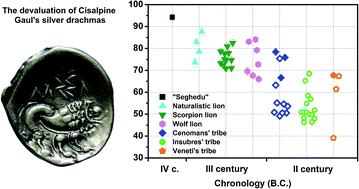Compositional analysis of a historical collection of Cisalpine Gaul's coins kept at the Hungarian National Museum
Abstract
The Cisalpine Gaul's coinage has been produced by different tribes settled in northern Italy between the 4th and the 1st century B.C. During this wide chronological period several types of silver drachms have originated, nowadays classified by numismatists in different typologies. To verify the presence of a debasement along the years and to investigate the exchange ratios among different drachmas, the rich collection of the Hungarian National Museum in Budapest has been analysed. Measurements have been performed at the Budapest Neutron Centre with the Prompt Gamma Activation Analysis (PGAA), a bulk technique which enables overcoming of surface enriched layers and alterations. This technique allows silver and copper to be quantified, while to check the presence of tin and other minor elements X-ray fluorescence (XRF) has been used. Results show that the silver content falls from 94% of the first emissions up to 50% of the Cenomans' and Insubres' tribes late typologies. This strong debasement takes place between the III and the II century B.C. and could be related to the military efforts in the decades around the second Punic war. At the same time, we observe the transition from a binary silver–copper alloy to a ternary one, made of silver, copper and tin.

- This article is part of the themed collection: Synchrotron radiation and neutrons in art and archaeology

 Please wait while we load your content...
Please wait while we load your content...